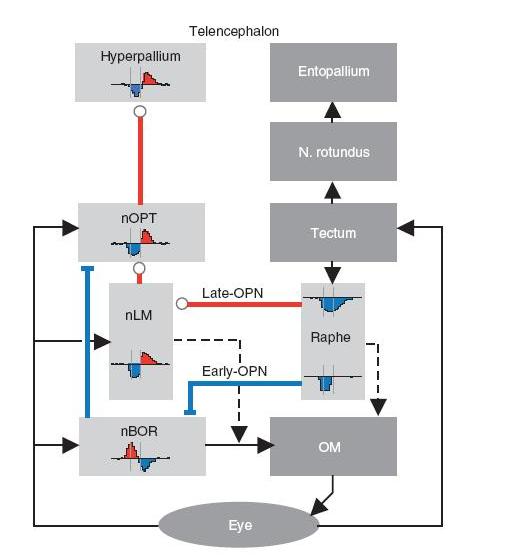Chinese Academy of
Sciences Protein
Science core facility
Center |
|
|
New Progress in the Studies of the Pigeon Visual System |
| Author: |
Scientific Administration Office of IBP |
Update time: |
2009-09-08 |
|
|
A saccadic eye movement causes a variety of transient perceptual sequelae that may be the results of corollary discharge. Here we show the neural circuits for saccadic corollary discharge that modulates activity throughout the pigeon visual system. Saccades in pigeons caused corollary discharge mediated inhibition followed by enhancement of firing activity in the telencephalic hyperpallium, visual thalamus, and pretectal nucleus (nLM) with opposite responses in the accessory optic nucleus (nBOR). Inactivation of thalamic neurons eliminated saccadic responses in telencephalic neurons; inactivation of both nLM and nBOR abolished saccadic responses in thalamic neurons. Saccade-related omnipause neurons in the brainstem raphe complex inhibited nBOR and excited nLM, while inactivation of raphe neurons eliminated saccadic responses in both optokinetic and thalamic neurons. It appears that saccadic responses in telencephalic neurons are generated by corollary discharge signals from brainstem neurons via optokinetic and thalamic neurons. These signals may play important roles in visual perception.
This paper has been evaluated as "must read" "new finding" by Prof. Marc Sommer (University of Pittsburgh, USA) and Prof. Dora Angelaki (Washington University School of Medicine, USA), Faculty of 1000 Biology (http://www.f1000biology.com/article/id/1108141):
Marc Sommer: Using a variety of techniques, this study delineates an entire circuit in the avian brain. The visual telencephalon in pigeons, homologous to striate cortex in primates, exhibits a mysterious decrease in activity just prior to, and during, an eye movement. How does this visual structure know about the imminent motor act? Yang et al. used neuronal recordings in combination with reversible inactivation and antidromic /orthodromic stimulation techniques to demonstrate that a copy - or corollary discharge - of the efferent oculomotor command is conveyed from brainstem areas, through a thalamus-like structure, up to the visual telencephalon. They speculate that this circuit may help to maintain useful visual perception despite the interruptions caused by eye movements.
Dora Angelaki: Using several elegant experiments, this study provides the first description of the neural circuits carrying saccade-related corollary discharge to the telencephalic hyperpallium, the avian homologue of the visual cortex. These circuits include the optokinetic nuclei and raphe complex that send corollary information to the telencephalon through the thalamus. Corollary information related to self-generated movements, like saccades, is critical in separating afference from reafference and creating a reliable neural representation of the world.

Figure: Summary diagram showing neuronal pathways and information flow related to saccadic responses in the structures under study (light gray rectangles; dark gray represents structures not studied here). Visual neurons in the telencephalic hyperpallium receive input from the nOPT, which in turn receives excitatory input from the nLM and inhibitory input from the nBOR. Meanwhile, the nLM receives excitatory input from the late omnipause
neurons (OPN) and the nBOR receives inhibitory input from the early omnipause neurons in the raphe complex. Dashed lines represent neuronal pathways identified in mammals26,36 but not yet identified in the pigeon from the pretectum and the brainstem reticular formation to the oculomotor nuclei (OM). Histograms show saccadic inhibition and enhancement of single
cells in their respective structures (15 repeats, time bin ? 50 ms). Vertical lines in histograms delimit saccadic duration. Excitatory pathways or enhancement in histograms is shown in red and inhibitory pathways or inhibition in blue.
|
|
|
|